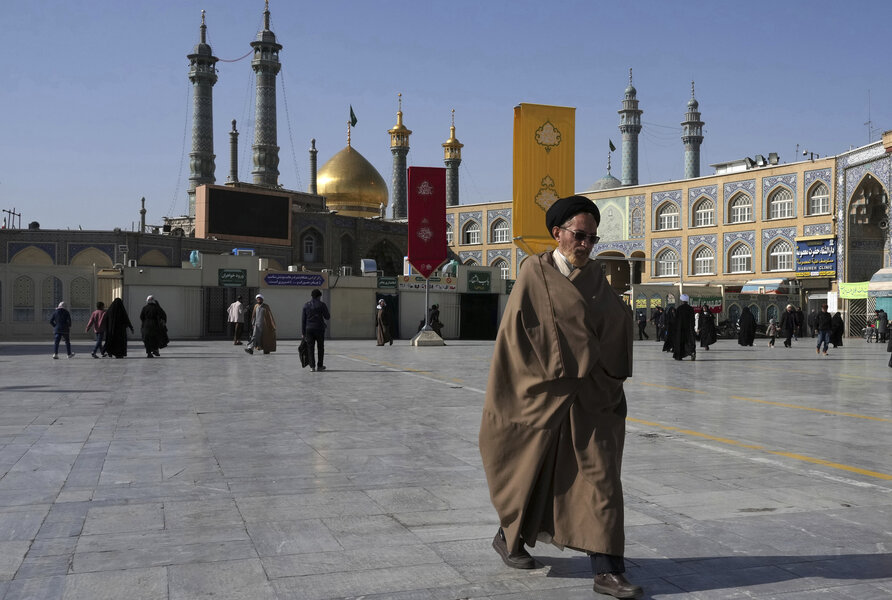Protests in Iran: A call for change from the holiest Shiite capital
Loading...
| Dubai, United Arab Emirates
Iran’s city of Qom is one of the country’s most important centers for Shiite Muslim clerics, packed with religious schools and revered shrines. But even here, some are quietly calling for Iran’s ruling theocracy to change its ways after months of protests shaking the country.
To be clear: Many here still support the cleric-led ruling system, which marked the 44th anniversary this month of Iran’s 1979 Islamic Revolution.
This includes support for many of the restrictions that set off the protests, such as the mandatory hijab, or headscarf, for women in public. They believe the state’s claims that Iran’s foreign enemies are the ones fomenting the unrest gripping the country.
But they say the government should change how it approaches demonstrators and women’s demands to be able to choose whether to wear an Islamic head covering or not.
“The harsh crackdown was a mistake from the beginning,” said Abuzar Sahebnazaran, a cleric who described himself as an ardent backer of the theocracy, as he visited a former residence of the late revolutionary leader Ayatollah Ruhollah Khomeini. “And the youth should have been treated softly and politely. They should have been enlightened and guided.”
Qom, some 125 kilometers (80 miles) southwest of Iran’s capital, Tehran, draws millions of pilgrims each year and is home to half of the country’s Shiite clerics. Its religious institutions graduate the country’s top clerical minds, making the city a power bastion in the country. The faithful believe the city’s dazzling blue-domed Fatima Masumeh Shrine represents a route to heaven or a place to have prayers answered for their woes.
For Iran today, the woes are many.
Protests have rocked the country since September 2022 after the death in custody of Mahsa Amini, an Iranian-Kurdish woman who had been detained by morality police over alleged improper dress. The demonstrations initially focused on the mandatory hijab, soon morphed into calls for a new revolution in the country.
Activists outside the country say at least 528 people have been killed and 19,600 people detained in a crackdown that followed. The Iranian government has not provided any figures.
Meanwhile, Iran faces increasing pressure abroad over enriching uranium closer than ever to weapons-grade levels following the collapse of Iran’s 2015 nuclear deal with world powers. Renewed sanctions worsen longstanding financial problems, pushing its currency – the rial – to historic lows against the dollar.
“Many protesters either had economic problems or were influenced by the internet,” Mr. Sahebnazaran said from inside Khomeini’s former home, which bore pictures of the ayatollah and Iranian flags.
Protesters have even vented their anger directly at clerics, whom they see as the foundations of the system. Some videos circulated online show young protesters running up behind clerics on the street and knocking off their turbans, a sign of their status. Those wearing a black turban claim descent directly from Islam’s Prophet Muhammad.
The scattered videos are a sign of the alienation felt by some toward the clergy in a nation where, 44 years ago, clerics helped lead the revolution against Shah Mohammad Reza Pahlavi.
“This was part of enemy plans, they wanted to tell people that the clerics are the reason behind all problems and high prices,” Mr. Sahebnazaran said. “But the clergy are being impacted by the inflation like the rest of the people. Many clerics live on tuition fees at the lowest economic level of society. The majority of them face the same problems as the people do.”
Seminary students receive some $50 a month, with many working as laborers or taxi drivers. Fewer than 10% of Iran’s 200,000 clerics have official posts in the government.
Sakineh Heidarifard, who voluntarily works with the morality police in Qom and actively promotes the hijab, said arresting women and forcefully taking them into police custody isn’t a good idea.
She said the morality patrols are necessary, but if they find violators they should give them a warning. “Use of force and coercion is not correct at all. We should talk to them with a soft and gentle tone, with kindness and care,” she said.
Still, she sees the hijab as a central tenet of the Islamic Republic. “We have sacrificed a lot of martyrs or blood to keep this veil,” she said. “God willing, it will never be removed from our heads.”
Changes in approach, however, are not likely to satisfy those calling for the wholesale rejection of the cleric-run government. Politicians in the reform movement for years have been urging change within the theocratic system to no avail, and many protesters have lost patience.
Also, the ever-growing economic pressure on Iran’s 80 million people may one day explode across all of society, said Alireza Fateh, a carpet salesman standing next to his empty shop in Qom’s traditional bazaar.
“Economic collapse is usually followed by political collapse ... and unfortunately this is what is happening here,” he said.
“The majority of the population ... still have a little left in their bank accounts. But someday they will take to the streets too, someday soon. Soon the poor, those who can’t make ends meet, will take to streets definitely.”
This story was reported by The Associated Press.





